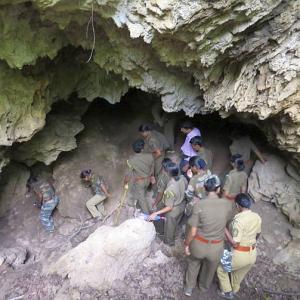
'We are rushing to 'develop' without carefully valuing natural areas.'
'With careful land use planning and scientific zonation at least 5 to 10 per cent of the country's land can be secured for tigers and other such species, and another 5 to 15 per cent kept under low-impact uses to support biodiversity that can coexist with human uses.
Tuesday, January 20, was a good news day for anyone who has stopped breathing in a jungle, waiting for a tiger to emerge. Or wants to.
A jubilant Environment Minister Prakash Javadekar wrote the figure on a board: 2,226.
That was the estimated number of tigers in the country last year, up 30 per cent from what it was in 2011.
To understand how the Royal Bengal Tiger has gone from on the verge of being wiped out to an animal that India wants to lend other countries, Sumit Bhattacharya/Rediff.com spoke to Dr Ullas Karanth, one of the world's foremost authorities on the big cat, who is director, Wildlife Conservation Society's India Programme.
 Dr Karanth, left, has for over the last two decades and more been at the forefront of studying tigers in Karnataka, which Tuesday's figures say is the No 1 tiger state in the country.
Dr Karanth, left, has for over the last two decades and more been at the forefront of studying tigers in Karnataka, which Tuesday's figures say is the No 1 tiger state in the country.
He is one of the pioneers of wildlife conservation in India, and his central work has been with what is now revealed as the largest tiger population in the world: In the Karnataka-Kerala-Tamil Nadu forests that were once was the lair of Veerappan: The Mudulalai-Bandipur-Nagarhole-Wayanad complex.
In 2006, it looked like the tiger was on the decline; now it looks like it is roaring back. What has changed? Is this a real spurt in tiger numbers or is it because more areas have been surveyed and the census has used more scientific methods?
Central government has vastly increased grants for tiger recovery after 2006. I think tiger numbers have increased in some areas where the state forest departments have utilised these grants effectively to improve reserve protection and to relocate villages.
In other areas tigers are in decline.
Overall, I believe the situation has improved, although the methods used to generate these estimates over wider regions are not very reliable.
In the last census, you had said there are deficiencies in the methodology. Are you satisfied this time?
The double sampling method used to generate numbers over wider regions continues to be a flawed approach as earlier. However, monitoring of source populations (in protected forests) that hold 90 per cent of the tigers within about 20 per cent of remaining habitat have shown some improvement.
If implemented properly some of these Phase IV protocols can yield reliable estimates of tiger numbers in reserves.

Is this the first tiger census with the Extract Compare software that you helped develop? Did earlier censuses take into account only pugmarks?
Earlier approach of trying to do a 'census' or a total count from pugmarks simply did not work. I had begun to take an entirely different approach, one that involves sampling tiger populations -- rather than total counts -- as far back as 1991.
Such sampling can use photographic captures of tigers using camera traps or even DNA extracted from tiger scats to identify individuals.
Thereafter, powerful statistical models employing capture-recapture theory can use these identifications to estimate tiger numbers and densities.
It took about 20 years for the government to recognise its utility. This came about largely because the Tiger Task Force, which the prime minister set up in 2005, forced the abandonment of the pugmark census.
The software had a limited role in this overall change: It basically automates and speeds up identification and matching of tiger photos.
You have argued against government monopoly on counting tigers. Has that been broken down, given that NGOs participated in this census?
The current survey had a slightly higher degree of non-governmental participation in just one piece of the action: Monitoring of some source populations under Phase 1V section 3 protocols. Even my own WCS team participated.
While this is an improvement, I am recommending something more radical: Totally separating reserve management and protection carried out by the government agencies from the ecological monitoring or audits to be done by a consortium of qualified researchers.
This will bring in more transparency, greater rigour, and will cost far less.
Similarly, evaluation of voluntary village relocation, park management evaluation as well as nature tourism could be entrusted to outsiders, enabling park managements to focus on improving protection without being distracted by tasks for which they are not professionally trained.
Is it true that people have been moved out of core areas of the protected forests and that has helped tiger numbers? Where is this most evident?
This has been true ever since Project Tiger began in 1973. Wherever villages have moved out conflict has come down, collusion in poaching has reduced and negative impacts on habitats have come down.
Good examples are in Bhadra and Nagarahole, where I have been working for two decades or more.
And the people are better off too as all data indicate.

How does it tie in -- or not -- with the recent land acquisition ordinance that does away with local consent for infrastructure projects and suchlike?
Land acquisition ordinance is not very relevant to the context of resettlement of individual families from deep interior tiger forests.
In this case, folks without land holdings such as landless labourers also need to be compensated fairly and generously.
The valuation and compensation has to fare more generous, because costs of resettling in more developed areas will be far higher. But it can be done as shown in Bhadra and now in Kudremukh gradually.
Who should get credit for this policy of rehabilitation, if you agree that it has helped?
It has helped. The government had made it a policy way back in the 1970s, but implementation was poor and unfair.
Local partners of the WCS got involved in Nagarahole and Bhadra about two decades ago to make the process fair, generous and voluntary by working closely with local people. Some good models were demonstrated.
Now, driven by economic change and peoples own desire for development, demand for such relocation has a huge momentum behind it.
There are thousands of families pleading for relocation and the government response is not always swift as it should be. This is where the forest manager's and development agencies' core task lies in the future.
What policies/legislation have helped the tiger; and which ones have hurt it? Have the Special Tiger Protection Forces helped?
The major conservation laws of 1970s and 1980s, such as the Wildlife Protection Act, the Forest Conservation Act and the Environmental Protection Act have all helped hugely.
The more recent Forest Rights Act, where it has been inappropriately interpreted or applied, has caused harm to forests as well as thwarted many poor families who want to move out of remote forests.
I do not think the Tiger Protection Force has made as much of a difference as is being made out. However, increasing flexibility in hiring local youth into these forces as well as increased levels of other staff recruitment in several states have both helped substantially.
Does tourism help or hurt the tiger, given that it needs inviolate forests? Has the practice of reducing the number of vehicles going into national parks per day helped?
Tourism being non-consumptive in nature can help tigers provided it is carried out sensibly. However, quite often it is not; then it causes problems of crowding, resource depletion and blocking of animal movement, habituation of animals (to people) etc.
Regulation of vehicle numbers has helped I think, but what we need are visitation quotas and pre-booking systems for even day visitors.
Present walk-in visitor system is leading to overuse of key reserves. However, business interests do not like such regulations and will try to resist.

Are you worried about the government's industrialisation push affecting tigers? Can a growing India also grow its tigers or is there a trade-off/sacrifice that one has to make in order for the country to have more wildlife?
Given that India's land area is 3,000,000 sq km and that even under the best of scenarios tiger forests cannot be more a 100,000 or 200,000 sq km out of these, I think there is room for both if we can use the land wisely to sustain landscapes rather than plan human use and intrusions everywhere.
With careful land use planning and scientific zonation at least 5 to 10 per cent of the country's land can be secured for tigers and other such species, and another 5 to 15 per cent kept under low-impact uses to support biodiversity that can coexist with human uses.
Remaining land may be put under intensive agricultural, urban and industrial uses.
I also think the ongoing population shift away from land-based to urban, industrial and service sectors will reduce biomass harvest pressures on natural habitats and could even contribute to wildlife habitat recovery.
We need to embrace science and technology rather than shun it in the quest for some golden age in the past, to reach these goals.
You have worked for years to cultivate a conservation ethos among forest populations. Are local communities buying in more and more into the importance of protecting the tiger?
I think the awareness began in upper and middle classes four decades ago and expanded. But in recent years as poverty has declined, and wages and education have improved, a larger section of the population is getting more interested in, and tolerant of, wildlife.
One even finds in some cases, village communities are trying to save big cats that get snared or trapped in human landscapes as opposed to brutally killing them, which was the routine in the past.
Yes I think attitudes are changing, but there is huge cultural variation across the country.
What are some of the things we as a country are still dong wrong?
We are rushing to 'develop' without carefully valuing natural areas and planning to save them in over reasonable fraction of the land.
Secondly, nature conservation is still very much locked into the top-down, bureaucracy-driven mode; this does not encourage public participation, private sector initiatives and infusion of modern science.
This framework needs to change radically in the conservation sector too, as it has in the business and other sectors.
Too much government monopoly is hampering conservation at this point.
Has poaching reduced? Has the demand of tiger parts from China declined?
Overall, across large parts of India -- except in the forest rich tribal belts in central and eastern India -- poaching has come down quite a bit. The demand for tiger and other wildlife parts from China has actually increased unfortunately and a wider array of animals such as the poor pangolin are also now a part of the global trade.
What is the prognosis for the health of India's forests that are responsible for the health of the tiger? Which areas of the country are doing it better and why/how?
Most extensive forests are tribal belts but they are not healthy in the sense that the animals have been hunted out. Wildlife is doing better in other, more developed parts of India as improved wages; job opportunities, education and changing culture have all contributed to reduced pressure on wildlife and habitats.
The Western Ghats -- in Kerala, Karnataka, Goa, and Tamil Nadu -- and Uttarakhand account for a major spurt in the numbers. What has helped?
Here the quality of habitats is better, forest departments are better run and organised, and the conservation NGO sector is more active. That makes a difference.
Villagers in many places in the higher reaches of Uttarakhand swear that there are tigers around. Is there any evidence -- given the Uttarakhand spurt in the census -- that tigers are moving to higher reaches? Pugmarks have been found in the snow in Bhutan, for instance.
Tigers do cross passes at these high elevations but since there is no stable prey suitable for them they do not reside there.
Are there new places where there are tigers now, or is it that they were always there but have been accounted for the first time?
I think more than new places -- that is expansion of tiger range -- what we are seeing is increase in densities and numbers in better protected reserves. I believe where tigers are there their tracks and other signs are usually visible. More advanced methods are required only if you want to know numbers.
With the numbers of tigers up, what are the new challenges? Many environmentalists say the government’s river-linking project will destroy a lot of tiger habitat, for example in the Ken-Betwa river belts in Panna.
Are there plans to link protected forests; because tigers disperse over large spaces? Are there tiger corridors that are examples of good forest management?
Of course, with the emerging economic growth and development that people have recently voted for so vigorously, we could lose a lot of connectivity among tiger forests. As in the case of Panna we could lose the core areas too.
An urgent need now is to prepare a scientifically designed system of protected areas, minimal use zones and intensive use zones. This is do-able if the best science is brought to bear on the task. I hope this happens sooner rather than later.
If not we may pay a heavy price in terms of sacrificing natural capital to reach developmental aspirations. I hope the newly set up the National Institution for Transforming India Aayog (NITI Aayog) would apply its mind to this task.
What would you like to remind the average Indian interested in conserving India's wildlife?
A worrying threat for natural areas -- be they be forests, mountains, streams or deserts -- is emerging from unthinking support, promotion and economic subsidies that are driving the proliferation of green energy projects such as wind power, solar power and micro and mini-hydropower schemes that are invading some of the best and remotest natural habitats.
No one even seems to appreciate the damage and destruction they will cause if the site selection does not consider biodiversity values of a location or area.
This is really an urgent problem that needs close examination.
Celebrate India's tigers! If you have captured a tiger on your camera or phone, please post the photograph right here. Do tell where you shot the picture.










